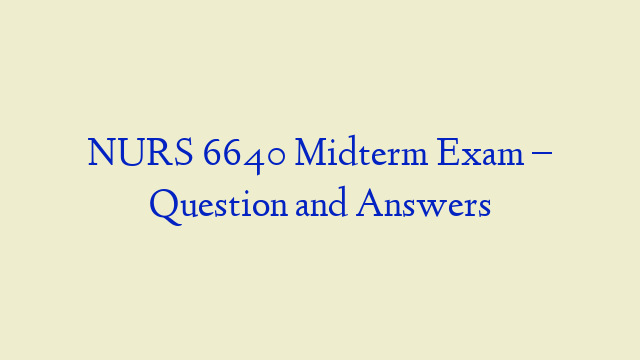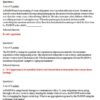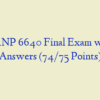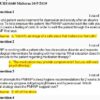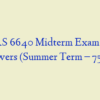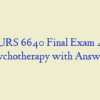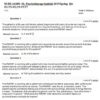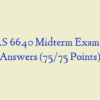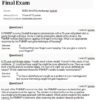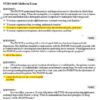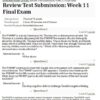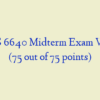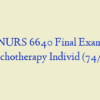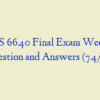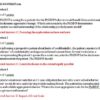Description
NURS 6640 Midterm Exam
- A PMHNP is caring for a 21-year-old woman who is suffering from anxiety and is having difficulty managing stress. Which of the following would be an appropriate step by the PMHNP?
- The PMHNP is working with a 56-year-old man who is being seen because of his anxiety and depression. During the therapy sessions, the PMHNP assists the patient in discussing his experiences and expanding on his thoughts and feelings. He tells the PMHNP stories about how he used to be teased by his coworkers at the office for becoming too anxious in large conference rooms. The PMHNP listens to the patient and helps focus on his strengths to promote self-understanding. Which principle best accounts for the PMHNP?s interactions with the patient?
- The PMHNP is working with an adult patient who has somatic complaints caused by a history of childhood abuse. As part of the therapeutic process, what does the PMHNP do to assess and organize a trauma history?
- One of the strategies the PMHNP wants to try includes sleep restriction. What will the PMHNP suggest to follow sleep restriction therapy?
- A 35-year-old patient seeks treatment for depression and anxiety after an abusive relationship. To help empower the patient, the PMHNP wants to teach the safe-place exercise to create a feeling of calm. In order to walk the patient through the exercise, the PMHNP first says:
- A PMHNP?s patients have already signed confidentiality agreements, including limits that will be imposed on confidentiality. Months later, the state?s laws have changed that affect confidentiality promises the PMHNP has already made. What is an appropriate step for the PMHNP to take after finding out this information?
- The PMHNP is working with a school-aged child who has been diagnosed with depression. The child has attended several sessions with the PMNHP, but recently presents with avoidant behavior by showing increased distress and being late to sessions. What approach does the PMHNP need to employ with the child to continue making therapeutic progress?
- The PMHNP is working with a patient who experiences anxiety around her parents that later leads to poor impulse control. What will the PMHNP do to employ psychodynamic psychotherapy properly for this patient?
- The PMHNP is working with a patient who seems dissatisfied with the therapeutic relationship. The PMHNP invites the patient to discuss her feelings regarding the PMHNP openly and honestly. It becomes clear to the PMHNP that they are experiencing an alliance rupture. How does the PMHNP repair the therapeutic alliance?
- The PMHNP is caring for a patient with borderline personality disorder. Using a psychoanalytic psychotherapy approach, the PMHNP attempts to intensify the patient?
- The patient is a 56-year-old female patient diagnosed with panic disorder and reports symptoms that include heart palpitations, frequent trembling, and feelings of choking in stressful situations. What special consideration does the PMHNP make?
- A 65-year-old patient has suffered the loss of his wife. He is in a state of hyperarousal with increased sympathetic nervous system arousal. One or more interventions may help the patient to deal with this arousal. To decrease sympathetic nervous system arousal, the PMHNP?s treatment strategy is .
- The PMHNP is caring for a patient who the PMHNP believes would benefit from a relational psychodynamic approach to therapy. Which action made by the PMHNP demonstrates appropriate use and understanding of the relationship psychodynamic model?
- The PMHNP has a session with a patient who was injured and traumatized from an explosion at the industrial plant where he used to work. During the session, an outside noise startles the patient and he experiences a flashback of the loud boom from the explosion. The PMHNP witnesses the patient present with anxiety and belabored breathing. What is the appropriate action of the PMHNP?
- The PMHNP is working with a veteran who has posttraumatic stress disorder (PTSD). The PMHNP believes that dual awareness will be beneficial in allowing the patient to focus on the here and now. What strategies can the PMHNP use to develop dual awareness in the patient?
- The PMHNP is working with a patient who experiences abreactions when discussing repressed feelings of his sexual abuse as a child. What can the PMHNP do to manage the patient?s intense emotional reactions?
- When a PMHNP is seeing a patient for the first time, what is an important step to assure that the patient and provider understand the limits of their discussion?
- An 11-year-old patient has been exhibiting low self-esteem at school and acting out. According to Maslow?s hierarchy of needs, which of the following questions would best be addressed first by the PMHNP?
- A patient who has borderline personality disorder is meeting with the PMHNP. When asked about future goals, the patient responds, “I?d like to go back to school to do what you do. You know, talk to people all day about their problems. It seems pretty easy.” How does the PHMNP respond to the client in a way that is free from any stigmatizing beliefs or judgments?
- During cognitive behavioral therapy (CBT), a 64-year-old male patient, states, “My wife hates me! She?s just waiting for me to die.” Using Socratic dialogue (SD) the PMHNP demonstrates understanding of analysis when she responds:
- The PMHNP is working with a patient who is living in poverty and abusing substances. According to the treatment hierarchy framework, what needs does the PMHNP need to attend to first?
- When conducting an initial assessment, a PMHNP has finished conducting a mental status examination with 10 minutes left in the session. The patient is distressed and would like to continue sharing her personal history. True or false: An appropriate response that the PMHNP might tell the patient is, “I understand that you are upset. [Summarizes diagnosis, treatment recommendations, and follow-up plan.] We can continue the conversation next week. How does this time next Monday work for you?”
- The PMHNP is assessing a patient who grew up in a foster home because she was neglected and abused by her birth parents at a young age. The patient admits to having difficulty forming and maintaining relationships throughout her life. Understanding maladaptive schemas, which statement does the PMHNP predict that the patient is likely to make?
- The PMHNP has been assisting a shy and timid 23-year-old male patient struggling with esteem and self-concept issues. Over the weekend, this patient was given the task of completing an exercise that would usually cause him distress and shame, also called a shame-attacking exercise. The PMHNP determines that this task has successfully been achieved when the patient states:
- The PMHNP is treating a patient with a substantial fear of feeling closed in (claustrophobia). Thus, the patient will not get into an elevator. The office where he works is on the 10th floor and this requires that he walk up and down the stairs in the morning and evening to get to his office. With permission from the patient, the PMHNP is beginning systematic desensitization to address the patient?s need to use the elevator. What is the PMHNP?s best plan of action?
- At the initial interview with a patient, the PMHNP reviews the condition of receiving services, including limits that will be imposed on confidentiality. During the discussion, the patient shares information that the PMHNP is legally required to report. True or false: If the PMHNP does not report information that s/he is legally required to report, state laws govern the consequences which include penalties for not reporting,especially child and elder abuse.
- The PMHNP is working with a patient who witnessed her father pass away after suffering for several months from terminal cancer. The PMHNP sees this as a traumatic event. The patient reports sometimes feeling out of touch with surroundings; almost as if things feel like a dream. “Sometimes that sensation lingers for a while,” the patient says, “and other times I snap out of it quickly.” What does the PMHNP infer about the condition based on psychotherapy concepts for trauma?
- A PMHNP is preparing confidentiality forms for his patients. What is the most appropriate first step he should take?
- During a clinical assessment of a 15-year-old patient, the PMHNP asks, “How can I help you?” The patient answers by saying, “Honestly, I don?t really think I need any help.” Which of the following is the most appropriate response by the PMHNP?
- The PMHNP understands that anxiety and depression are two disorders in which their symptoms may overlap. When discussing this, you explain that the autonomic nervous system is activated and further helps distinguish anxiety symptoms by making the following points:
- The patient attempts the PMHNP?s sleep hygiene recommendations for 2 weeks, but does not make any progress mitigating nightmares and hyperarousal. Which behavioral strategy does the PMHNP suggest next?
- True or false: If after a third round of processing followed by stabilization, a patient has increased anxiety that requires further interventions aimed at stabilization, the therapeutic relationship can no longer successfully provide therapeutic change.
- A 62-year-old patient has been diagnosed with borderline personality disorder. Upon assessment, the PMHNP learns that he participates in spending sprees and occasional binge eating, accompanied by rapid changes in self-image. Which evidence-based psychotherapeutic model does the PMHNP identify as effective and beneficial?
- A patient named Steve is seeking therapy to get help with his home situation, stating that he has been stressed since his mother-in-law moved into the house. What can the PMHNP do to assist the patient in constructing a narrative?
- The PMHNP is meeting with a new patient who is a young veteran back from serving two tours overseas. When reviewing the patient?s health history file that was sent from the VA, the PMHNP learns that several months ago, the patient was diagnosed with PTSD, but never followed up with treatment for it. After a comprehensive mental health assessment, the PMHNP confirms the PTSD diagnosis and understands that which therapeutic approach will be the most effective as a first-line treatment modality?
- The PMHNP is meeting with a 42-year-old man with depression brought on by the recent passing of his wife. As he describes the circumstances surrounding his late wife?s death, the PMHNP begins to feel sad. The sadness lingers for several hours, and the PMHNP finds it difficult to focus on other patients for the rest of the day. What is the most appropriate explanation for the reaction that the PMHNP is experiencing?
- During a session, the PMHNP asks a patient with a history of sexual abuse to recall the relationship she had as a child with her parents. The patient responds by saying she has a headache and her stomach hurts, and starts talking about her physical ailments. What is the appropriate response by the PMHNP?
- The PMHNP is mentoring a student. After working with a patient during a session, the student laments about all the things she should have, or could have, said to the patient. “I feel guilty that I didn?t speak up more about the patient?s concern toward her son,” says the student. The PMHNP understands that the student is exhibiting signs of which therapeutic concept?
- The PMHNP is caring for a patient who has acute stress disorder after experiencing a traumatic event 1 week prior. The PMHNP wants to begin with a therapeutic framework that follows the adaptive information processing (AIP) model. What is the priority action for the PMHNP to take?
- A 41-year-old male patient is meeting with the PMHNP and reveals that he is homosexual. He begins telling the PMHNP about his feelings as a homosexual, middle- aged man. The PMHNP nods understandingly. Before long, the patient asks, “Are you gay? Are you married? Do you have kids?” What is the best response by the PMHNP?
